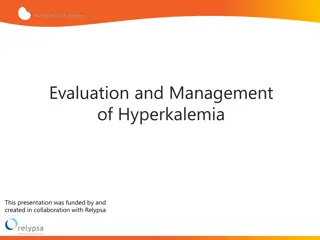Understanding Hypokalemia and Potassium Regulation
Hypokalemia is a condition characterized by low potassium levels, crucial for intracellular functions. The Na+/K+ ATPase pump maintains the ICF/ECF gradient. Potassium excretion occurs mainly via the kidneys, with minimal variation in proximal tubule reabsorption. The collecting duct plays a vital role in regulating urinary K+ excretion, adapting to excess or depletion states. Key channels and pathways are involved in potassium absorption and secretion processes.
Download Presentation

Please find below an Image/Link to download the presentation.
The content on the website is provided AS IS for your information and personal use only. It may not be sold, licensed, or shared on other websites without obtaining consent from the author. Download presentation by click this link. If you encounter any issues during the download, it is possible that the publisher has removed the file from their server.
E N D
Presentation Transcript
A PPROA C H TO H YPOK A L E M IA Dr. GOKUL KRISHNAN(JR1) Dr. GOKUL KRISHNAN(JR1)
Potassium Chief Intracellular Cation ECF : 3.5 5.5 mEq/L (1-2%) ICF : 100-150 mEq/L (30x / 98%) Chief regulator of ICF/ECF gradient : Na+/K+ ATPase Pump Total Body Pool Of Potassium : 3000- 3500 mEq
ICF/ECF Concentration Maintained by Na+/K+ ATPase Pump Cellular K+ uptake is rapid and it limits the rapid increase in serum potassium concentration Shift from ICF to ECF also occurs when serum K+ is less
Potassium Excretion In a healthy individual at steady state, the entire daily intake of potassium is excreted Approx. 90% in the urine and 10% in the stool Kidney plays a dominant role in potassium homeostasis Serum Potassium almost completely ionized, not bound to any plasma proteins: Hence effectively filtered by glomerulus
Maximum absorption : PCT (65%) Passive (all ions except Mg++) Other sites: 1. Descending Loop : Secretion 2. TAL (25%) 3. DCT (15%) 4. P cells of Cortical CD (excretion) 5. intercalated cells There is only little variation in proximal tubule potassium reabsorption in response to hypokalemia or hyperkalemia. Major variations occurs at the level of potassium excretion.
1. NKCC Channel Active 2 Positive 2 negative ion inside 2. ROMK Channel takes out K+ to lumen positive charge in lumen 3. Paracellular Pathway Absorption of Ca++ Mg++
Role of Collecting Duct The collecting duct is the primary site at which the kidney regulates urinary K+ excretion. The collecting duct has the ability both to secrete K+, enabling adaptation to K+ excess states, and to actively reabsorb K+, enabling adaptation to K+ depletion states.
The principal cell, particularly in the cortical collecting duct, secretes potassium, whereas intercalated cells throughout the entire collecting duct reabsorb potassium.
1. EnaC apical Na+ entry Amiloride sensitive generates a negative potential difference in lumen drives passive K+ exit through apical K+ channels 2. ROMK / KiR 1.1 apical K+ channels the bulk of constitutive K+ secretion 3. Flow-sensitive big potassium (BK) or maxi-K K+ channel increases in distal flow rate genetic absence of ROMK
Factors influencing principal cell potassium secretion 1. Luminal flow rate (most Important) 2. Distal sodium delivery 3. Aldosterone 4. Extracellular pH
Apical H+-K+-ATPase Reabsorb K+ from Lumen Secretes H+ Potassium depletion increases H+-K+-ATPase expression Aldosterone increases H+-K+- ATPase expression
The presence of two separate potassium transport processes, secretion by principal cells and reabsorption by intercalated cells, contributes to rapid and effective regulation of renal potassium excretion.
HYPOKALEMIA-Definition Serum potassium <3.5 mEq/L occurs in up to 20% of hospitalized patients 10-fold increase in in-hospital mortality
Causes of Hypokalemia 1. Psuedohypokalemia 2. Reduced Intake 3. Increased translocation into cells 4. Increased Loss a. Renal b. GIT c. Sweat d. Dialysis e. Plasmapheresis
Pseudohypokalemia artefactual decrease in serum potassium, after phlebotomy in vitro cellular uptake of K+ after venipuncture MCC : Acute Leukemia Large numbers of abnormal leukocytes take up potassium when the blood is stored in a collection vial for prolonged periods at room temperature
Reduced Intake Average Person : 40 120 mEq/Day Recommended : Close to 120 mEq/day Mostly excreted : Urine If Intake low : Kidney excretes Low K+ (conserves) decrease in intake rarely causes hypokalemia Decrease in intake can increase the severity of hypokalemia if there is already existing other causes of hypokalemia Ex: Diuretic Therapy
Translocation into cells Mechanism: Na+ K+ ATPase Action Causes: 1. Increased availability of insulin 2. Increased Beta Agonist activity 3. Alpha Antagonism 4. Alkalosis 5. Hypokalemic Periodic Paralysis
Increased 2 Agonism activation of 2-adrenergic receptors stimulates Na+K+ ATPase , inducing cellular potassium uptake and decreasing serum K+ (Possibly also by increasing the release of insulin - UPTODATE) ( 1-adrenergic receptor activation has the opposite effect) UNEXPECTED HYPOKALEMIA 2 agonist as bronchodilators in treatment of asthma Dobutamine in treatment of heart failure
Tocolytics : Ritodrine Pseudoephedrine and ephedrine in cough syrup or dieting agents Theophylline intoxication/ Caffeine : xanthine- dependent activation of c-AMP dependent signaling (downstream to 2receptor 2 agonist must be used with caution in 1. Hypertensives on diuretic therapy 2. Preterm labor on treatment with Ritodrine as tocolytic
Stress induced alterations in the activity of the endogenous sympathetic nervous system can cause hypokalemia sometimes : 1. 2. 3. 4. Alcohol withdrawal Hyperthyroidism Acute myocardial infarction Severe head injury
Hypokalemic Periodic Paralysis FAMILIAL HYPOKALEMIC PERIODIC PARALYSIS Genetic Profound Hypokalemia M>F Never occurs after 25 yrs of age THYROTOXIC PERIODIC PARALYSIS a/w hyperthyroidsm Profound hypokalemia F>M
FAMILIAL HYPOKALEMIC PERIODIC PARALYSIS Missense mutations : 1. 1 subunit of L-type calcium channels (type 1) 2. skeletal Na+ channel (type 2) Acute Attacks in which sudden movement of potassium occurs into cells Profound Hypokalemia (1.5 2.5) Precipitated often by rest following exercise stress and carbohydrate rich meals Serum potassium normal in between the attacks Low urinary potassium excretion
THYROTOXIC PERIODIC PARALYSIS periodic attacks of hypokalemic paralysis Asian or Hispanic origin genetic variation in a thyroid hormone responsive K+ channel : Kir2.6, present in muscles weakness of the extremities and limb girdles (frequently between 1 and 6 am) Signs and symptoms of hyperthyroidism are not invariably present Mechanisms 1. activation of the Na+/ K+ ATPase 2. -adrenergic activity High-dose propranolol (3 mg/kg) rapidly reverses the associated hypokalemia, hypophosphatemia, and paralysis
Other causes of transcellular shift Potassium repletion associated Paradoxical Hypokalemia Increased Blood cell production: due to uptake Vitamin B12/ Folate administration GM-CSF administration Hypothermia Barium intoxication Cesium intoxication Chloroquine intoxication Antipsychotic drugs ( Risperidone, Quetiapine)
GI LOSS Upper GI Loss Lower GI Loss UGI secretion : 5-10 mEq/L 1. Vomiting LGI Secretion : 20 50 mEq/L 1. Diarrhea 2. Laxatives 3. Tube drainage 4. Villous adenoma 5. VIPoma 6. Persistent Infective Diarrhea Alone cannot cause hypokalemia as such Since K+ Conc is very low
Vomiting : Acid Loss Reduced pH : Metabolic Alkalosis Upper GI Loss Compensation: HCO3- excretion More HCO3-Reaches Collecting duct Hypovolemia More electronegativity in lumen Aldosterone Secretion K+ Excretion K+ Excretion
Lower GI Loss Mechanism 1. Bicarbonate Loss 2. Hyperchloremic Metabolic Acidosis Other Causes of LGI Loss: 1. Bowel Cleaning for colonoscopy : PEG, Sodium Phosphate 2. Ogilvies Syndrome 3. Geophagia
1. 2. Increase elecro Negativity in lumen 1.Increase Na/Water delivery 3. Increase Electronegativity in Lumen 3. 2. Increase Aldosterone Activity
Diuretics any diuretics acting proximal to potassium secreting site can cause hypokalemia 1. CAi 2. Loop diuretics 3. Thiazides Mechanism 1. Increased Na delivery to distal tubule 2. Volume depletion RAS stimulation
Thiazide Produces more Hypokalemia than Loop diuretics Reason: Calcium Excretion Loop diuretics -> calcium excretion-> more calcium in lumen -> electronegativity in lumen is reduced -> Low K+ Excretion Thiazides -> less calcium excretion -> less calcium in lumen -> more electro negativity -> More K+ Excretion Hypokalemia produced by diuretics is dose dependent Lower dose of thiazides 12.5/25 mg/day of chlorthalidone & hydrochlorthiazide are now widely used. Effectively control hypertension Less Hypokalemia
Diuretic induced fluid and electrolyte complications occurs only during first two weeks of therapy Steady state attained (if oral intake is adequate) Stable patient with Normal serum potassium at 3 weeks has no risk of developing late hypokalemia Potassium monitoring not required Adequate oral intake No increase in dosing No other loses (GI: Gastroenteritis) If any one present: consider temporary cessation of diuretics
Increased Mineralo corticoid activity 1. Conns Syndrome 2. Appareant Mineralo Corticoid Excess
Non Reabsorbable Anions in CD 1. Proximal RTA 2. BetaHydroxyButyrate in DKA 3. High dose penicillin 4. Toluene induced metabolic acidosis (Glue Sniffing): hippurate Non reabsorbable Anions Increase Electronegativity in Lumen
What Happens in DKA ? 1. Glucose -Osmotic Diuretic : More Sodium and water to distal tubules 2. Dehydration aldosterone stimulation 3. Ketones - BetaHydroxyButyrate Non absorbable anion 4. Insulin infusion as treatment
Saltwasting Nephropathies 1. Bartter Syndrome 2. Gittleman Syndrome 3. Liddle Syndrome
HypoMagnesemia Mechanism uncertain Increase number of open ROMK channels Magnesium known to inhibit ROMK channels Also can coexist with hypokalemia in upto 40% cases Concurrent Potassium loses 1. Diuretic therapy 2. Tubular toxins : iphosphamide, gentamycin
AMPHOTERICIN B: increase permeability of cell membrane collecting duct LOW CALORIE DIETS: Atkins diet Polyuria
Clinical Features Muscular 1. Weakness : hyperpolarization of skeletal muscle 2. Rhabdomyolysis Smooth Muscle 1. Constipation 2. Bladder Dysfunction Endocrine 1. Carbohydrate Intolerance 2. Diabetes mellitus (Reduced insulin)
Cardiovascular changes ventricular and atrial arrhythmias predisposes to digoxin toxicity ECG Abnormalities
ECG Changes in Hypokalemia 1. 3.0 3.5 Reduced T wave Amplitude U waves 2. 2.5 3.0 Prolonged QT/QU interval Sagging of ST Segment 3. T and U almost Coalesce 4. <2.5 QRS Widening PR prolongation
DIAGNOSTIC APPROACH TO DIAGNOSTIC APPROACH TO HYPOKALEMIA HYPOKALEMIA
Goals Of Treatment 1. prevent life threatening complications 2. to replace the associated K+ deficit 3. to correct the underlying cause
Potassium Preparations Potassium can be administered as 1. potassium chloride 2. potassium phosphate : hypokalemia and hypophosphatemia proximal (type 2) RTA 3. potassium bicarbonate : hypokalemia and metabolic acidosis (eg: renal tubular acidosis / diarrhea)
Oral replacement with KCl is the mainstay of therapy in hypokalemia. Notably, hypomagnesemic patients are refractory to K+ replacement alone Concomitant Mg2+ deficiency should always be corrected with oral or intravenous repletion.
IV KCL therapy 1 Amp KCL = 10 ml = 20 mEq Approximatly 40 mEq of IV KCl raises Serum K+ by 0.5 mEq Indication of IV KCl: 1. Severe symptomatic Hypokalemia 2. Unable to take oral medications Saline is preferred over dextrose Pain/ Phlebitis (Rates >10mEq/hr)
DKA + Hypokalemia Insulin therapy should be delayed till S. potassium is above 3.3 Addition of potassium to NS will make it hypertonic solution. So 40-60 mEq of Potassium/Litre of Half NS is preffered
Redistributive hypokalemia Potential complication is rebound hyperkalemia, as the initial process causing redistribution resolves or is corrected. Such patients can develop fatal hyperkalemic arrhythmias
When excessive activity of the sympathetic nervous system is thought to play role in redistributive hypokalemia as in: 1. Thyrotoxic Periodic Paralysis 2. Theophylline overdose 3. Acute head injury High dose propranolol (3 mg/kg) should be considered; this nonspecific beta blocker will correct hypokalemia without the risk of rebound hyperkalemia.























